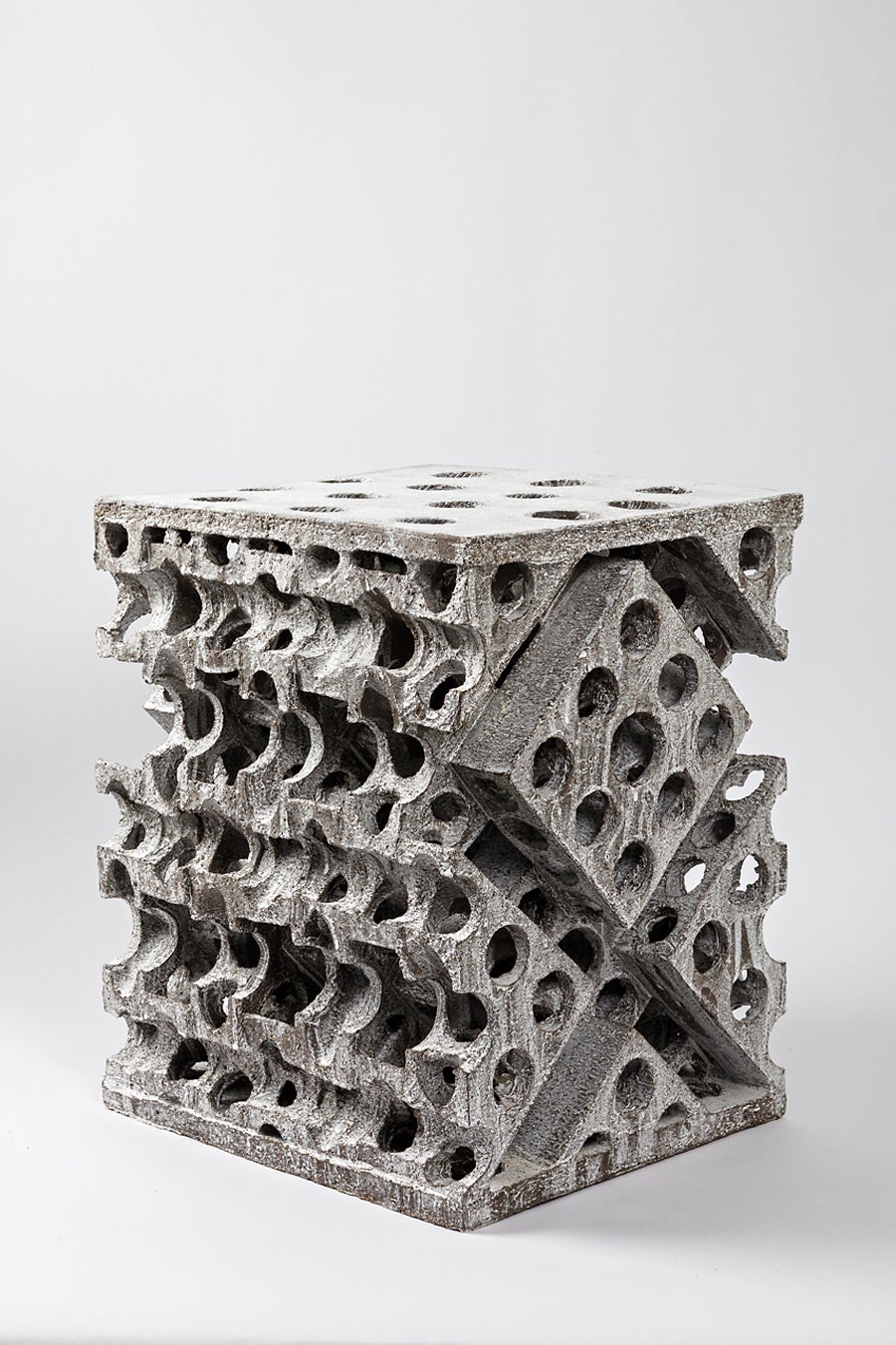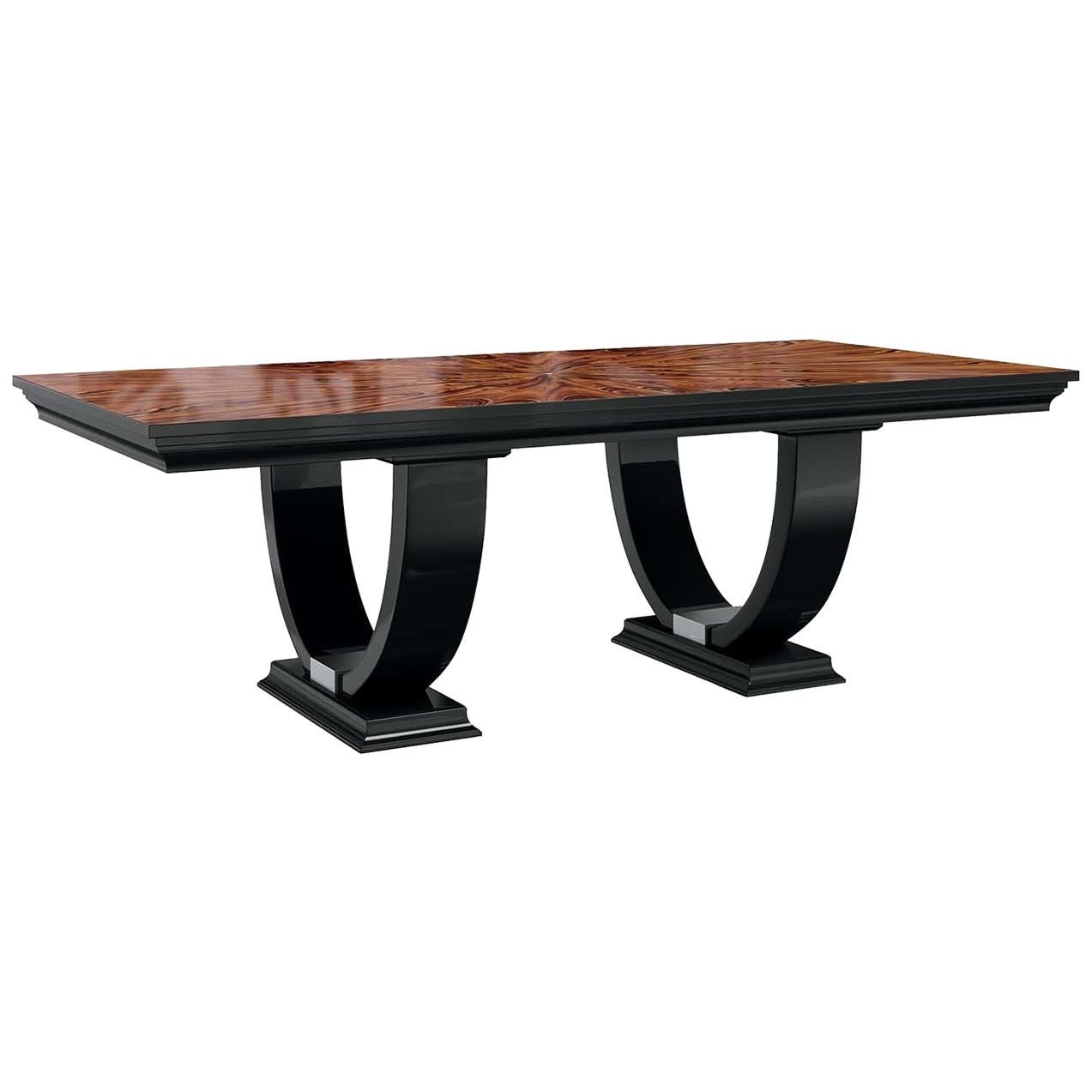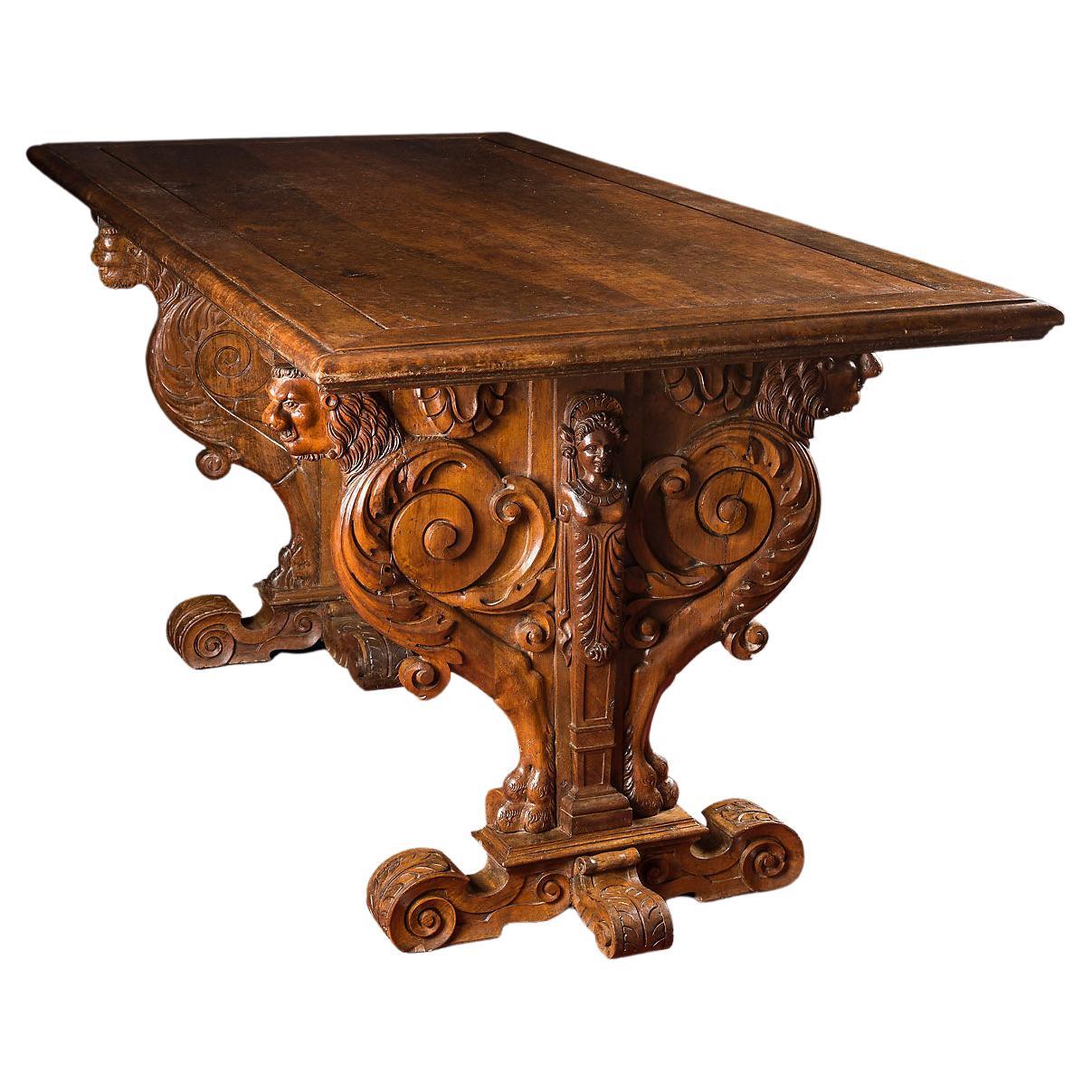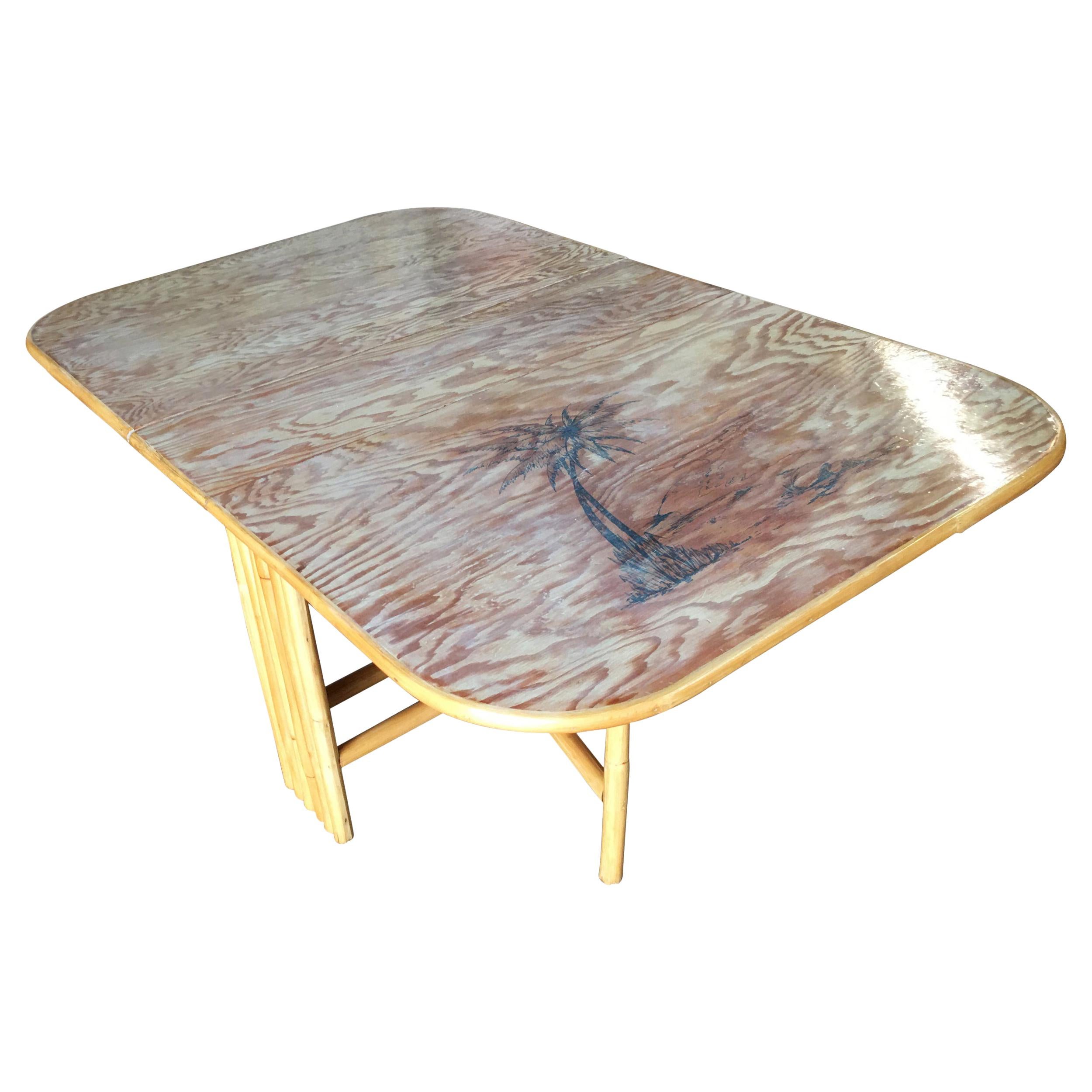Items Similar to Rare Renaissance Table with Fixed Top
Want more images or videos?
Request additional images or videos from the seller
1 of 7
Rare Renaissance Table with Fixed Top
About the Item
RARE RENAISSANCE TABLE WITH FIXED TOP
ORIGIN: FRANCE
PERIOD : SECOND HALF OF THE 16th CENTURY, c. 1560-1580
Height: 87 cm
Length: 158 cm
Width: 78 cm
Walnut wood
Good condition
This very beautiful table of "classical" composition and structure belongs to the stylistic trend that was born in Ile-de-France and Val-de-Loire in reaction to the ultramontane style that was then predominant in other regions. It is enriched with a profuse decoration spread over all the surfaces
Two fluted columns rise from two thick skids, decorated with scrolls and cherubs' heads, and joined by a wide crosspiece. The latter are flanked by two winged chimeras whose faces, with hooked noses and open mouths, are extremely expressive. Between the columns is a finely executed winged cherub head.
The belt, moulded in doucine and sculpted with palmettes, supports the top.
From the cross piece that connects the runners, three more balusters rise, joined by semi-circular arches.
The rigour of the composition, the balance of the masses and the scrupulous use of antique art attest to the fact that this table is a French creation from the second half of the 16th century.
The table with a fixed support was rare in the Middle Ages, with the exception of the monastery or guardroom table with a solid top supported by permanently assembled vertical posts. The medieval table generally consisted of a free-standing top that could be placed on flying trestles.
The first tables made up of two legs connected by a crosspiece and covered with sculptures first appeared in Italy, where they were inspired by the ancient cartibulum. In France, artists and cabinetmakers took up this ultramontane model and reinterpreted it to and reinterpreted it to suit French taste. The fan-shaped, caryatid, columned or balustered supports were adorned with sculptures, making them particularly decorative. They then became real luxury objects and aroused great interest.
The table then lent itself to the multiple variations created by the vision of the master ornamentalists. Jacques Androuet du Cerceau produced several drawings of porticoed or fan-shaped tables, although he was not the inventor.
Bibliography:
Jacques THIRION, Mobilier Moyen-âge et de la Renaissance en France, Editions Faton, 1999.
- Dimensions:Height: 34.26 in (87 cm)Width: 30.71 in (78 cm)Depth: 62.21 in (158 cm)
- Materials and Techniques:
- Period:
- Date of Manufacture:1560-1580
- Condition:Repaired. Wear consistent with age and use.
- Seller Location:Saint-Ouen, FR
- Reference Number:1stDibs: LU3115336022982

About the Seller
5.0
Vetted Seller
These experienced sellers undergo a comprehensive evaluation by our team of in-house experts.
Established in 2016
1stDibs seller since 2017
153 sales on 1stDibs
Typical response time: 7 hours
- ShippingRetrieving quote...Ships From: Paris, France
- Return PolicyThis item cannot be returned.
More From This SellerView All
- Rare Renaissance Table from Hugues Sambin SchoolLocated in Saint-Ouen, FRExcellent state of condition This table has a movable top and supports as did the models from the Middle Ages, and yet presents a decorative dimension characteristic of the Renaissance furniture, which the riche and most inventive type was the “fan-shaped” table, probably coming from Italy. The central pilaster represents a term enriched by a foliage motif, including a laurel-crowned femal face on the first support and a male face on the second one. The high quality of this embossed work adds a touch of sophistication. Noteworthy, we can see on the backside of the fan-shaped supports, the same patterns as a lower relief, an extremely rare occurrence. This Ceremonial Table can be moved, and can be used following the occasions , like a small dinner or a grand reception for exemple. We can admit that this table with a movable top and fan shaped movables supports is the single model known today. Furthermore the richness of ornamentation, the carefulness and high quality of the sculpture denote that this table has its origin in Hugues Sambin...Category
Antique 16th Century French Renaissance Dining Room Tables
MaterialsWalnut
- French Renaissance Table said "à l'italienne"Located in Saint-Ouen, FRMeasures: Closed length : 137 cm – opened lenght : 255 cm Beautiful table of the Second French Renaissance, said ‘à la du Cerceau’. It is in effect a model close to the projects d...Category
Antique 16th Century French Renaissance Dining Room Tables
MaterialsWalnut
- Rare Renaissance Florentine Cabinet with Certosina DecorationLocated in Saint-Ouen, FRRARE RENAISSANCE FLORENTINE WALNUT CABINET WITH CERTOSINA DECORATION ORIGIN: FLORENCE, ITALY PERIOD: END OF 15th CENTURY – BEGINNING OF 16th CENTURY Height: 129 cm Length: 107 cm...Category
Antique 16th Century Cabinets
MaterialsWalnut
- Rare Renaissance Caquetoire with a Perspective motif from LyonLocated in Saint-Ouen, FRThe trapezoidal armchair is a typically French creation from the second half of the sixteenth century. Although the nineteenth century gave it the name of "caquetoire", it was descri...Category
Antique 16th Century French Renaissance Armchairs
MaterialsWood, Walnut
- Rare Renaissance Cabinet Richly CarvedLocated in Saint-Ouen, FRThis rare Renaissance cabinet is richly decorated on the doors and drawers with carvings depicting the four seasons, and on the uprights and the entablature, alternating flower bouquets inlaid with mother of pearl. This is a beautifully conceived piece of furniture, representing a crowned portico with its entablature and cornice. The upper body Articulated separately in a ternary rhythm, as with the lower body, the upper part opens with two carved doors. The doors are framed by both the lateral uprights and the casing. There are cartouches carved into the casing in which mythological figures are depicted with flower bouquets. On the doors: On the right: Spring, a female figure crowned with a wreath of leaves, holding a basket full of flowers. She is wearing necklaces and bracelets on each arm, with drapery discretely wrapped around her body and is standing on a winged putti’s head. On each side are depicted a tree and a village with a steepled church. Above her head floats the three signs of the zodiac corresponding to the season: Aries, Taurus and Gemini. On the left: Summer, a bearded man crowned with ears of corn and bearing armfuls of corn. He is standing on a similar winged putti, flanked by a tree and an ear of corn. The following three signs of the zodiac appear: Cancer, Leo and Virgo. On the uprights and the central casing a number of smaller figures seem to represent virtues and vices that newly wedded couples should aspire to and avoid. On each side, at the bottom of the uprights, there is a dog representing fidelity. Above, a lion embodies power, wisdom, and justice. In between, on the left upright, there is a figure of noncombatant Athena wearing a helmet and holding a spear, an arrow pointing down and in her left hand, a shield, symbol of protective power. On the right upright, the goddess Venus controls the arrow of Cupid. The iconography here acts as a clear reminder of the required virtues that both parts of a young couple need to fulfill: fidelity, power, wisdom and justice. For him, the goddess Athena focuses on the power. Whereas for her, it is Venus who shows how to control Cupid’s arrow. On the central casing at the bottom, by way of contrast, there is a peacock, a symbol of pride and at the top, a monkey representing lust and mischief. In between, a woman holding a chain and a cup full of precious stones while on the floor sits a half empty opened casket. This can be interpreted as a symbol of extravagance. Above, the entablature, decorated with male figures resting on leaking urns, may symbolize the passing of time. They are flanked by two consoles decorated with acanthus leaves and separated by flower bouquets (inlaid with mother of pearl). Finally on top, a cornice acts as a crown for the piece of furniture. The lower body The moulded base stands on four round, flattened feet. Represented on the doors: On the left: Autumn, a stocky, naked man crowned with vine leaves, holding fruits in his right hand and with his left, picking a bunch of grapes from a climbing vine. Standing on a mound, he is surrounded by a vine and a hill, at the foot of which a man presses the grapes in a big vat after the harvest. Above the climbing vine appear the signs of Libra, Scorpio and Sagittarius. On the right: Winter, an elderly man wearing a fur cloak...Category
Antique 16th Century French Renaissance Cabinets
MaterialsWalnut
- Rare Italian Renaissance Perspectives Sideboard with Fan-shaped PedestalLocated in Saint-Ouen, FRRARE ITALIAN RENAISSANCE PERSPECTIVES SIDEBOARD WITH FAN-SHAPED PEDESTAL ORIGIN: TUSCANY, FLORENCE PERIOD: 16th CENTURY Height : 143.5 cm Length : 133 cm Depth : 54 cm Li...Category
Antique 16th Century Cabinets
MaterialsWalnut
You May Also Like
- Rectangular Oscar Fixed TableBy Guerra VanniLocated in Milan, ITThe attractive design of the new Oscar collection adapts to settings with an exquisitely contemporary and cosmopolitan flavor. This rectangular table has a sturdy structure and featu...Category
21st Century and Contemporary Italian Modern Dining Room Tables
MaterialsWood
- Fixed Table in Hardwood with Japanese Joinery and Danish AestheticsBy Finn Juhl, George Nakashima, Hans J. Wegner, Figure GroundLocated in Brooklyn, NYDuring a residence in Kyoto, Japan, studying Japanese wood joinery, One of Figure Grounds' Founding Partners, Tyler Putnam, struck inspiration for this table. There was never enough ...Category
2010s American Mid-Century Modern Tables
MaterialsOak, Walnut
- Renaissance TableBy DurameLocated in Milan, ITThis elegant table is inspired by the architecture of the historic European cities, particularly the rounded arc, typical of Renaissance buildings and cathedrals. The legs are in sol...Category
2010s Italian Tables
MaterialsOak
- Isabella Costantini, Italy, Marion Fixed Dining TableBy Isabella CostantiniLocated in Ascoli Piceno, ITDesigned by IC and crafted by expert Italian artisans, the dining table features a rectangular top supported by four curved legs. Its Minimalist look and modern design make it a piec...Category
2010s Italian Modern Dining Room Tables
MaterialsWood
- Rare Restored Gateleg Dining Table with Screen Printed Plywood TopLocated in Van Nuys, CAVery rare restored gateleg dining table with screen printed plywood top. The table folds in two directions for easy storage. Size: Open 24" tall x 31" wide x 49" deep Closed ...Category
Vintage 1950s American Mid-Century Modern Dining Room Tables
MaterialsWood
- Modern Italian Fixed Table in Concrete, Bontempi CollectionBy Bontempi CasaLocated in Titusville, PADesigned by Shannon Sadler, it is a solemn table with a strong visual impact, Podium captures attention for its sinuous but austere lines. The top lays on a solid and elegant concret...Category
21st Century and Contemporary Italian International Style Dining Room Ta...
MaterialsConcrete
Recently Viewed
View AllMore Ways To Browse
16th Monastery Table
Columns With Cherubs
Trestle Monastery Table
Trestle Table 16th Century
Antique French Renaissance Dining
First Table
Midcentury Modern Pedestal
Formal French Dining Table
Arne Vodder Oval Dining Table
Wood Crate Table
Midcentury Modern Teak Myanmar
24 Pedestal
Dining Room Oak Table
Rectangular Dining Table For 12
Small Extendable Dining Table And Chairs
Directoire Walnut Dining Table
Belgian Wood Dining Table
Sycamore Round Dining Table





